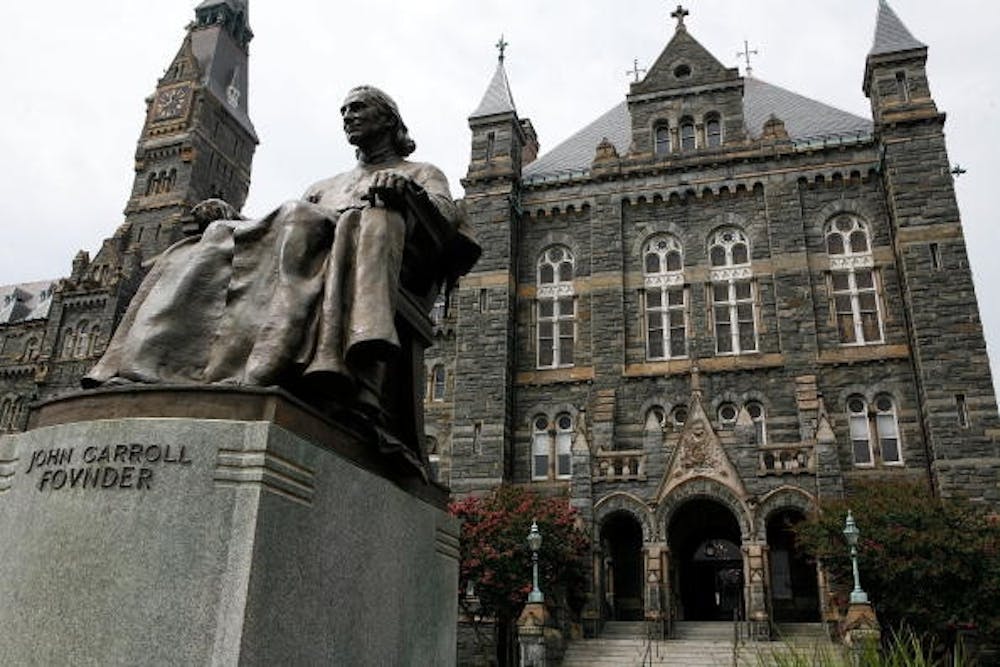By Camellia Carbonaro
Staff Writer
In the fall of 1838, Georgetown University’s early presidents, Thomas F. Mulledy and William McSherry, organized a large slave sale in an effort to pay off some of the college’s debts that were incurred under their poor leadership. Two hundred and seventy two slaves (consisting of men, women and children as young as two months old) were forcefully loaded onto human cargo ships and sent to Washington, D.C., where they were put up for auction and sold off to plantation owners, according to the New York Times.
Last fall, a large protest erupted at the university’s heart after the reopening of its student residence buildings, Mulledy and McSherry halls. Georgetown students demanded that the college change the names of the residence buildings so as not to commemorate these men. In addition, activists asked for the creation of plaques for the slaves’ unmarked graves still on campus, an annual program to openly explore Georgetown’s slave-related history, and mandatory diversity training for professors. Due to financial constraints, however, Georgetown President John DeGioia announced in November that while the school will not be able to meet all of the protest demands, it will change the names of the buildings to Freedom and Remembrance halls, as requested, according to Georgetown’s Website.

Georgetown is one of many premier institutions coming under fire for its past ties to slavery. Calhoun College, one of Yale’s 12 residential colleges, was also met with protests after it was discovered that it was named after John C. Calhoun, one of the 19th century’s foremost white supremacists who promoted slavery as a “positive good.”
Similarly, Duke and East Carolina universities had to recently remove the name Aycock from their buildings because the man they were named after was another white supremacist, the New York Times reported. Vanderbilt University also tried to change the name of its Confederate Memorial Hall, but was legally stopped by the United Daughters of the Confederacy, who paid for the building’s construction.
The New York Times reported that for universities established in the 18th and 19th centuries, a link to slaveholding is unavoidable. Most of the Southern institutions were built and tended to by slaves. Jody Allen, a visiting professor of history at the College of William and Mary, explained how we tend to not realize the fact that churches, businesses and universities owned slaves because it’s not openly shared, according to BBC. Mark Auslander, a history professor at Brandeis University, said universities like to focus on “their abolitionist, anti-slavery history and not talk about their connection to slavery” partly because of embarrassment, but also because they know that if the truth came out, a race war would ensue.
Within the last decade, historians have begun to unearth these ill-shaped roots, forcing some institutions to answer for what they had previously ignored or denied.
CNN reported that, in 2003, Brown University was the first college to publicly acknowledge its relations with slavery. In order to do so, its university president, Ruth Simmons (the first African-American to lead an Ivy League school), created The Committee on Slavery and Justice, composed of faculty, students and administrators who were tasked with investigating and preparing a comprehensive report about the university’s historical relationship to slavery and the transatlantic slave trade. The committee discovered that 30 members on Brown’s governing board at some time or another had owned or captained slave ships, as well as accepted donated slaves from wealthy parishioners to help with the university’s construction. The Brown family itself had owned slaves and engaged in the slave trade, with the exception of one abolitionist family member. Upon learning this, Brown set out to repair and improve relationships with their neighboring communities by setting up an education fund for children in Providence, R.I., and building a memorial for the enslaved.
In the words of Adam Rothman, a historian at Georgetown, “the university itself owes its existence to this history.” Rather than deny its past, Georgetown is looking to acknowledge what happened and try to make amends. In the end, it comes down to the question of whether or not the college is doing enough.
As of now, the New York Times reported that the Georgetown administration is working hard with its professors, students, alumni and genealogists to find the descendants of the 272 slaves and to determine what has to be done to make things right. Among these reparative possibilities, the administration is considering everything from a formal apology to scholarships for the descendants.










